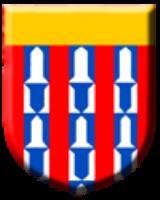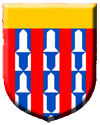
Saint-Pol-sur-Ternoise
Encyclopedia
Saint-Pol-sur-Ternoise is a commune
in the Pas-de-Calais department in northern France. The population of the canton
is 14,939.
-sur-Ternoise, usually referred to as just Saint-Pol, was originally a stronghold of the Counts of Flanders and was established as a county in the late 9th century. When the county passed out of the family of the Flemish counts, it remained subject to the Count of Flanders as his vassal
s until 1180. It became subjects to France, then Artois
(1237–1329), then France again until it ceased to exist as a county and was annexed to France in 1702.
Saint-Pol was first controlled by the Flemish counts, then by the family known as Candavne from early in the 11th century. In 1205 the county passed to the seigneurs
of Châtillon
through marriage, and remained with this dynasty until 1360 when it passed to the Luxembourg dynasty. Around 1487 the county passed to the Capetian-Bourbon-Vendôme dynasty through marriage, then to the Longueville-Neuchâtel dynasty from around 1563. In 1702 it came under direct rule of France.
In the Middle Ages
, several of the Counts of Saint-Pol were active in the Crusades
.

(1909–1986), humorist and actor.
Communes of France
The commune is the lowest level of administrative division in the French Republic. French communes are roughly equivalent to incorporated municipalities or villages in the United States or Gemeinden in Germany...
in the Pas-de-Calais department in northern France. The population of the canton
Cantons of France
The cantons of France are territorial subdivisions of the French Republic's 342 arrondissements and 101 departments.Apart from their role as organizational units in certain aspects of the administration of public services and justice, the chief purpose of the cantons today is to serve as...
is 14,939.
History
The county of Saint-PolCounty of Saint-Pol
The county of Saint-Pol was a county around the French city of Saint-Pol-sur-Ternoise on the border of Artois and Picardy, formerly the county of Ternois....
-sur-Ternoise, usually referred to as just Saint-Pol, was originally a stronghold of the Counts of Flanders and was established as a county in the late 9th century. When the county passed out of the family of the Flemish counts, it remained subject to the Count of Flanders as his vassal
Vassal
A vassal or feudatory is a person who has entered into a mutual obligation to a lord or monarch in the context of the feudal system in medieval Europe. The obligations often included military support and mutual protection, in exchange for certain privileges, usually including the grant of land held...
s until 1180. It became subjects to France, then Artois
Artois
Artois is a former province of northern France. Its territory has an area of around 4000 km² and a population of about one million. Its principal cities are Arras , Saint-Omer, Lens and Béthune.-Location:...
(1237–1329), then France again until it ceased to exist as a county and was annexed to France in 1702.
Saint-Pol was first controlled by the Flemish counts, then by the family known as Candavne from early in the 11th century. In 1205 the county passed to the seigneurs
Fiefdom
A fee was the central element of feudalism and consisted of heritable lands granted under one of several varieties of feudal tenure by an overlord to a vassal who held it in fealty in return for a form of feudal allegiance and service, usually given by the...
of Châtillon
Châtillon-sur-Marne
Châtillon-sur-Marne is a commune in the Marne department in north-eastern France.It lies in the valley of the Marne River, surrounded by the Parc Naturel de la Montagne de Reims. It lies in the historic province of Champagne...
through marriage, and remained with this dynasty until 1360 when it passed to the Luxembourg dynasty. Around 1487 the county passed to the Capetian-Bourbon-Vendôme dynasty through marriage, then to the Longueville-Neuchâtel dynasty from around 1563. In 1702 it came under direct rule of France.
In the Middle Ages
Middle Ages
The Middle Ages is a periodization of European history from the 5th century to the 15th century. The Middle Ages follows the fall of the Western Roman Empire in 476 and precedes the Early Modern Era. It is the middle period of a three-period division of Western history: Classic, Medieval and Modern...
, several of the Counts of Saint-Pol were active in the Crusades
Crusades
The Crusades were a series of religious wars, blessed by the Pope and the Catholic Church with the main goal of restoring Christian access to the holy places in and near Jerusalem...
.
Flanders dynasty
- *Baldwin I Iron Arm (?-879), Count of FlandersCount of FlandersThe Count of Flanders was the ruler or sub-ruler of the county of Flanders from the 9th century until the abolition of the position by the French revolutionaries in 1790....
(858-879) - *Baldwin II the Bald (879-883) and (892-918), Count of FlandersCount of FlandersThe Count of Flanders was the ruler or sub-ruler of the county of Flanders from the 9th century until the abolition of the position by the French revolutionaries in 1790....
(879-918)
Flanders dynasty (restored)
- Adalolf (918-933)
- Arnulf I the Great (933-962), Count of FlandersCount of FlandersThe Count of Flanders was the ruler or sub-ruler of the county of Flanders from the 9th century until the abolition of the position by the French revolutionaries in 1790....
(918-64) - Arnulf II (962-988), Count of FlandersCount of FlandersThe Count of Flanders was the ruler or sub-ruler of the county of Flanders from the 9th century until the abolition of the position by the French revolutionaries in 1790....
(964-88) - Baldwin IV the Bearded (988-c. 1023), Count of FlandersCount of FlandersThe Count of Flanders was the ruler or sub-ruler of the county of Flanders from the 9th century until the abolition of the position by the French revolutionaries in 1790....
(988-1036)
Candavne dynasty
- Roger I (c. 1023 - 1067)
- Hughes I (1067–1070)
- Guy I (1070–1083)
- Hugues II (1083–1130)
- Hugues III (1130–1141)
- Enguerrand (1141–1150)
- Anselme (1150–1174), son of Hugues III
- Hugues IV (1174–1205)

Châtillon dynasty
- Gauchier (1205–1219), married Elisabeth, daughter of Hugues IV
- Guy II (1219–1226), son of Gauchier
- Hugues V (1226–1249), son of Gauchier. Count of BloisCount of BloisThe County of Blois was originally centred on Blois, south of Paris, France. One of the chief cities, along with Blois itself, was Chartres. Blois was associated with Champagne, Châtillon , and later with the French royal family, to whom the county passed in 1391...
(1230–1241) - Guy III (1249–1289), son of Hugues V
- Hugues VI (1289–1292), son of Guy III. Count of Blois (1283–1307)
- Guy IV (1292–1317), son of Guy III
- Jean I (1317–1344), son of Guy IV
- Guy V (1344–1360), son of Jean I
Luxembourg dynasty
- Guy VI (1360–1371), married Mahaut, daughter of Jean I
- WaleranWaleran III of Luxembourg, Count of LignyWaleran III of Luxembourg , Count of Ligny and Saint Pol, was a French nobleman and soldier.He was the son of Guy of Luxembourg, Count of Ligny and Mahaut of Châtillon, Countess of Saint Pol. He succeeded his father in 1371, after his death at the Battle of Baesweiler...
(1371–1415) - Philip (1415–1430)
- JeanneJeanne of LuxembourgJoan, Countess of Saint-Pol and Ligny , called the Demoiselle de Luxembourg, was the daughter of Guy of Luxembourg, Count of Ligny and Mahaut of Châtillon, Countess of Saint-Pol....
(1430) - Pierre IPeter of Luxembourg, Count of Saint-PolPeter of Luxembourg was a son of John of Luxembourg, Lord of Beauvoir and his wife Marguerite of Enghien. His inheritance included the counties of Brienne, Conversano and Saint-Pol.- Family :...
(1430–1433) - Louis ILouis de Luxembourg, Count of Saint-PolLouis de Luxembourg, Count of Saint-Pol, of Brienne, de Ligny, and Conversano belonged to the Ligny branch of the House of Luxemburg and was Constable of France....
(1433–1475) - Jean II (1475–1476)
- Pierre II (1476–1482)
- MarieMarie de LuxembourgMarie of Luxembourg was a French noblewoman, the elder daughter and principal heiress of Pierre II de Luxembourg, Count of Saint-Pol, by Margaret, a daughter of Louis, Duke of Savoy...
(1482–1547)
Capet-Bourbon-Vendôme dynasty
- François IFrançois, Count of VendômeFrançois de Bourbon was a French nobleman. He was the Count of Vendôme.He was the son of Jean VIII, Count of Vendôme, and Isabelle de Beauveau. At his father's death when he was 7, he became Count of Vendôme...
(1487–1495) jure uxorisJure uxorisJure uxoris is a Latin term that means "by right of his wife" or "in right of a wife". It is commonly used to refer to a title held by a man whose wife holds it in her own right. In other words, he acquired the title simply by being her husband.... - François IIFrancis de Bourbon, Count of St. PolFrancis I de Bourbon-Saint-Pol, Count of St. Pol and of Chaumont , was a French nobleman, Count of Saint-Pol, Duke of Estouteville and important military commander during the Italian Wars.Francis was the second son of Francis, Count of Vendôme and Marie of Luxembourg, Countess of Vendôme.He was...
(1495–1545) - François III (1545–1546)
- Marie II (1546–1601), succession disputed by the following:
- John III (1557)
- François IV (1560–1563)
- Léonor (1563–1573)
- François V (1601–1631)
- Henry (1631–1663)
- Jean Louis (1663–1668) and (1672–1694)
- Charles-Paris (1668–1672)
- Marie III (1694–1705)
- after her, the County reverts to Louis XIV, King of FranceLouis XIV of FranceLouis XIV , known as Louis the Great or the Sun King , was a Bourbon monarch who ruled as King of France and Navarre. His reign, from 1643 to his death in 1715, began at the age of four and lasted seventy-two years, three months, and eighteen days...
, and is incorporated into his dominions
- after her, the County reverts to Louis XIV, King of France
Notable people
Saint-Pol-sur-Ternoise was the birthplace of Pierre ReppPierre Repp
Pierre Repp was a French humorist and actor. His real name was Pierre Alphonse Léon Frédéric Bouclet. On 14 August 1930, he married Ferdinande Alice Andrée Bouclet in Lille.Famous for his unique stuttering talent...
(1909–1986), humorist and actor.

